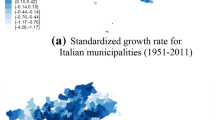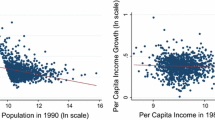Abstract
Economic growth and β-convergence of American states 1963–2015 is analyzed adjusting for significant spatial autocorrelation with system-GMM by considering the four Census macro regions individually. The Census regions converged over the last 50 years with both physical and human capital contributing to growth. In an early era (1963–1983), convergence was higher with rates varying between 4.7 and 1.5%, while for a later era (1984–2015) the rate was below 1% which is below the standard of 2% but fits well with a neoclassical growth paradigm. The Midwest region had the highest rate of convergence in the early era but then had almost no convergence in the later era with the other three regions having very low but positive convergence. Unlike many earlier studies, human as well as physical capital accumulation empirically supports economic growth as theory predicts.




Similar content being viewed by others
Notes
The estimates were run with attention to using similar instruments and orthogonal deviations to do comparable both unfiltered and filtered regressions. The main changes are observed in the rate of convergence and the elasticities between income and its factors (human and physical capital). The filtered values offer a better adjustment according to the theory. Also, the assumption of normality is at times not satisfied and some unfiltered regressions suffer from weak instruments. Some coefficients of the factors are even negative with unfiltered regressions contrary to theory. The authors can provide the unfiltered results upon request.
References
Ackley, C.A., D.J. Lundberg, I.T. Elo, S.H. Preston, and A.C. Stokes. 2021. County-level estimates of excess mortality associated with COVID-19 in the United States, medRxiv preprint, 2021.04.23.21255564. https://doi.org/10.1101/2021.04.23.21255564
Ali, K., M.D. Partridge, and M.R. Olfert. 2007. Can Geographically Weighted Regressions Improve Regional Analysis and Policy Making? International Regional Science Review 30(3): 300–329.
Andersson, M., and U. Gråsjö. 2009. Spatial Dependence and the Representation of Space in Empirical Models. The Annals of Regional Science 43: 159–180.
Anselin, L. 2005. Exploring Spatial Data with GeoDa: A Workbook, Center for Spatially Integrated Social Science. Chicago: University of Illinois, Urbana-Champaign.
Anselin, L., and S. Rey. 1991. Properties of Tests for Spatial Dependence in Linear Regression Models. Geographical Analysis 23(2): 112–131.
Arbia, G., R. Basile, and G. Piras. 2005. Using Spatial Panel Data in Modelling Regional Growth and Convergence (September 2005). ISAE Working Paper No. 55. Available at SSRN: https://ssrn.com/abstract=936321.
Arellano, M., and S. Bond. 1991. Some Tests of Specification for Panel Data: Monte Carlo Evidence and an Application to Employment Equations. The Review of Economic Studies 58(2): 277–297.
Arellano, M., and S. Bond. 1998. Dynamic Panel Data Estimation using DPD98 for Gauss: A Guide for Users. Madrid: CEMFI.
Badinger, H., W.G. Müller, and G. Tondl. 2004. Regional Convergence in the European Union, 1985–1999: A Spatial Dynamic Panel Analysis. Regional Studies 38(3): 241–253.
Barro, R.J. 2015. Convergence and Modernization. The Economic Journal 125(585): 911–942.
Blanco, G., and R. Ram. 2019. Level of Development and Income Inequality in the United States: Kuznets Hypothesis Revisited Once Again. Economic Modelling 80: 400–406.
Blundell, R., and S. Bond. 1998. Initial Conditions and Moment Restrictions in Dynamic Panel Data Models. Journal of Econometrics 87(1): 115–143.
Brainerd, E. and Siegler, M.V. (2003). The Economic Effects of the 1918 Influenza Epidemic. CEPR Discussion Paper No. 3791, www.cepr.org/pubs accessed 3/10/2020.
Caselli, F., G. Esquivel, and F. Lefort. 1996. Reopening the Convergence Debate: A New Look at Cross-Country Growth Empirics. Journal of Economic Growth 1: 363–389.
El-Shagi, M., and S. Yamarik. 2018. State-Level Capital and Investment: Refinements and Update, CFDS Discussion Paper 2018/1. Keifang, Henan, CHINA: Center for Financial Development and Stability at Henan University.
Ertur, C., J. Le Gallo, and C. Baumont. 2006. The European Regional Convergence Process, 1980–1995: Do Spatial Regimes and Spatial Dependence Matter? International Regional Science Review 29(1): 3–34.
Felipe, J. and J. McCombie. 2012. Problems with Regional Production Functions and Estimates of Agglomeration Economies: A Caveat Emptor for Regional Scientists, Working Paper #725, Levy Institute of Economics of Bard College, Annandale-on-Hudson NY, USA.
Fingleton, B. 2001. Equilibrium and Economic Growth: Spatial Econometric Models and Simulations. Journal of Regional Science 41(1): 117–147.
Fischer, M.M. 2011. A Spatial Mankiw-Romer-Weil Model: Theory and Evidence. The Annals of Regional Science 47: 419–436.
Fischer, M.M. 2016. Spatial Externalities and Growth in a Mankiw-Romer-Weil World: Theory and Evidence. International Regional Science Review 41(1): 45–61.
Ganong, P. and D.W. Shoag. 2017. Why Has Regional Income Convergence in the U.S. Declined? NBER Working Paper #23609, Cambridge: National Bureau of Economic Research.
Garofalo, G.A., and S. Yamarik. 2002. Regional Convergence: Evidence from a New State-by-State Capital Stock Series. Review of Economics and Statistics 84(2): 316–323.
German-Soto, V., and G. Brock. 2015. Strength in Diversity: A Spatial Dynamic Panel Analysis of Mexican Regional Industrial Convergence, 1960–2003. Comparative Economic Studies 57(1): 183–202.
Getis, A., and D.A. Griffith. 2002. Comparative Spatial Filtering in Regression Analysis. Geographical Analysis 34(2): 130–140.
Getis, A., and J.K. Ord. 1992. The Analysis of Spatial Association by Use of Distance Statistics. Geographical Analysis 24(3): 189–206.
Hanushek, Eric A. 2016. Will More Higher Education Improve Economic Growth? Oxford Review of Economic Policy 32(4): 538–552.
Heckelman, J., and J. Dinan. 2013. Empirical Evidence Regarding Regional Political Convergence in the United States. The Journal of Regional Analysis & Policy 43(2): 170–177.
Heckelman, J.C. 2013. Income Convergence among U.S. States: Cross-Sectional and Time Series Evidence. Canadian Journal of Economics/revue Canadienne D’economique 46(3): 1085–1109.
Hines Jr., J.R.. 1996. Altered States: Taxes and the Location of Foreign Direct Investment in America. American Economic Review 86(5): 1076–1094.
Holmes, T.J. 1998. The Effect of State Policies on the Location of Manufacturing: Evidence from State Borders. Journal of Political Economy 106: 667–705.
Islam, N. 1995. Growth Empirics: A Panel Data Approach. Quarterly Journal of Economics 110: 1127–1170.
Johnson, N., W. Rugers, J. Sorens, and S. Yamarik. 2014. Corruption, Regulation, and Growth: An Empirical Study of the United States. Economics of Governance 15(1): 51–69.
Johnson, P.A. 2000. A Nonparametric Analysis of Income Convergence Across the US States. Economics Letters 69: 219–223.
Johnson, P.A., and L.N. Takeyama. 2001. Initial Conditions and Economic Growth in the US states. European Economic Review 45(4–6): 919–927.
Kalemli-Ozcan, S., A. Reshef, B.E. Sorensen, and O. Yosha. 2010. Why Does Capital Flow to Rich States? Review of Economics and Statistics 92(4): 769–783.
Kosfeld, R., and J. Lauridsen. 2004. Dynamic Spatial Modelling of Regional Convergence Processes. Empirical Economics 29: 709–722.
Lehmann, H., A. Oshchepkov, and M.G. Silvagni. 2020. Regional Convergence in Russia: Estimating a Neoclassical Growth Model. Institute of Labor Economics Discussion Paper No. 13039, Bonn FRG: IZA
Maestas, N., K.J. Mullen, and D. Powell. 2016. The Effect of Population Aging on Economic Growth, The Labor Force and Productivity, Rand Working Paper WR 1063-1, The Rand Corporation, Santa Monica CA, USA.
Mankiw, N.G., D. Romer, and D.N. Weil. 1992. A Contribution to the Empirics of Economic Growth. Quarterly Journal of Economics 107(2): 407–437.
Mitchener, K.J., and I.W. McLean. 2003. The productivity of U.S. States since 1880. Journal of Economic Growth 8(1): 73–114.
Mulligan, C.E., and X. Sala-i-Martin. 2000. Measuring Aggregate Human Capital. Journal of Economic Growth 5(3): 215–252.
Papyrakis, E., and R. Gerlagh. 2007. “Resource Abundance and Economic Growth in the United States. European Economic Review 51: 1011–1039.
Partridge, M.D. 1997. Is Inequality Harmful for Growth? Comment. American Economic Review 87: 1019–1032.
Partridge, M.D. 2005. Does Income Distribution Affect US State Economic Growth. Journal of Regional Science 45(2): 363–394.
Ram, R. 2021. Income Convergence Across the US States: Further Evidence from New Recent Data. Journal of Economics and Finance 45(2): 372–380.
Ravallion, M. 2012. Why Don’t We See Poverty Convergence? American Economic Review 102(1): 504–523.
Shiller, R.J. 2019. Narrative Economics: How Stories Go Viral & Drive Major Economic Events. Princeton: Princeton University Press.
Temple, J. 1999. The New Growth Evidence. Journal of Economic Literature 37: 112–156.
Turner, C., R. Tamura, and S.E. Mulholland. 2013. How Important are Human Capital, Physical Capital and Total Factor Productivity for Determining State Economic Growth in the United States, 1840–2000? Journal of Economic Growth 18(4): 319–371.
U.S. Census Bureau (2021). https://www2.census.gov/geo/pdfs/reference/GARM/Ch6GARM.pdf. Accessed 4/21/2021
Welch, F. 1999. In Defense of Inequality. American Economic Review 89: 1–17.
Williams, M., and R.L. Moomaw. 1989. Capitol and Labour Efficiencies: A Regional Analysis. Urban Studies 26: 573–585.
Yamarik, S. 2006. Solow and the States: New Evidence. Regional Studies 40(6): 571–582.
Yamarik, S. 2011. Human Capital and State-Level Economic Growth: What is the Contribution of Schooling. The Annals of Regional Science 47(1): 195–211.
Yu, J., and L.F. Lee. 2012. Convergence: A Spatial Dynamic Panel Data Approach. Global Journal of Economics 1(1): 1–36.
Acknowledgements
We thank two anonymous referees for detailed comments that great improved the paper and assistance from the editor.
Author information
Authors and Affiliations
Corresponding author
Additional information
Publisher's Note
Springer Nature remains neutral with regard to jurisdictional claims in published maps and institutional affiliations.
Rights and permissions
About this article
Cite this article
German-Soto, V., Brock, G. Overall US and Census Region β-Convergence 1963–2015 Controlling for Spatial Effects. Comp Econ Stud 64, 44–67 (2022). https://doi.org/10.1057/s41294-021-00159-y
Accepted:
Published:
Issue Date:
DOI: https://doi.org/10.1057/s41294-021-00159-y




